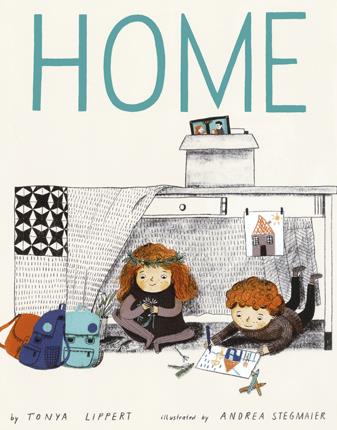| Home Author: Lippert, Tonya K. | ||
| Price: $21.88 | ||
Summary:
Two children learn from their experiences of homelessness and uncertain housing that despite their living circumstances there are aspects of their lives that remain constant.
| Illustrator: | Stegmaier, Andrea |
Reviews:
School Library Journal (04/01/22)
Booklist (+) (02/15/22)
Full Text Reviews:
Booklist - 02/15/2022 *Starred Review* Lippert, who herself often experienced homelessness as a child, here shines a light on the hidden problem of unhoused children. She focuses on two kids, Wes and Clare, who live with their mother and father in a cozy house with a white picket fence. Homelessness isn’t on their radar—a remarkable early illustration shows the kids and their mother, all in color, walking past an old woman, rendered in black and gray, who is begging on the sidewalk outside her tent home. Then suddenly, the family starts on a downward spiral, with scenes changing from their house to someone’s apartment to a motel to a shelter, with the word nowhere repeated in big black lettering. The text and illustrations (with the children remaining in color while everything around them is black and gray) brilliantly represent their fear and disorientation. At book’s end, the family moves into a new house with the knowledge that it’s love and family that make a home. In a note at the end, Lippert tells her own story and urges caregivers to talk to children about homelessness, which, according to one of Lippert’s sources, the National Center on Child Homelessness, affects 1 out of every 30 U.S. children. A compassion- and-action-awakening book. - Copyright 2022 Booklist.
Booklist - 02/15/2022 *Starred Review* Lippert, who herself often experienced homelessness as a child, here shines a light on the hidden problem of unhoused children. She focuses on two kids, Wes and Clare, who live with their mother and father in a cozy house with a white picket fence. Homelessness isn’t on their radar—a remarkable early illustration shows the kids and their mother, all in color, walking past an old woman, rendered in black and gray, who is begging on the sidewalk outside her tent home. Then suddenly, the family starts on a downward spiral, with scenes changing from their house to someone’s apartment to a motel to a shelter, with the word nowhere repeated in big black lettering. The text and illustrations (with the children remaining in color while everything around them is black and gray) brilliantly represent their fear and disorientation. At book’s end, the family moves into a new house with the knowledge that it’s love and family that make a home. In a note at the end, Lippert tells her own story and urges caregivers to talk to children about homelessness, which, according to one of Lippert’s sources, the National Center on Child Homelessness, affects 1 out of every 30 U.S. children. A compassion- and-action-awakening book. - Copyright 2022 Booklist.
School Library Journal - 04/01/2022 Gr 1–4—From a writer who is a social worker and who experienced homelessness as a child, this is an affecting story of lost and found. Clare and Wes, both redheads, live in the Brown House with their mother, who looks like them, and their father, who has dark hair and brown skin. Clare makes flower wreaths to beautify the house and Wes draws pictures for its walls. Then one day they experience a "big change" and say good-bye to Brown House, but with "nowhere of their own to arrive," they stay in various places. Ultimately, they end up at a shelter while awaiting permanent housing: "Somewhere was better than Nowhere. And Anywhere." Meanwhile the kids attend school, finding comfort in their friends and the routine despite the anxiety about where they live and the questions it elicits. Finally, they move into Blue House, but "They never forgot what it was like to be Nowhere, Somewhere or Anywhere." Without needing to name every single emotion, Lippert covers a lot of territory in the text including happiness, confusion, anger, sadness, and hope. Her occasionally ambiguous text, unexpected word order, and punctuation slow the story, allowing readers to decipher what is happening. But if the deliberately vague language softens what is unfolding, the book remains a good starting point for empathy, representation, and discussion. Precisely rendered illustrations, of people, paths, and home after home, capture the changing landscape and give the text an assist. Stegmaier effectively renders the family and specific items (luggage, pictures, etc.) in color against a black-and-white palette for focus. Includes an author's note and additional resources. VERDICT This book covers an important topic on which few picture books are written, and may help children, those experiencing homelessness or not, make sense of this economic and emotional hardship.—Catherine Callegari - Copyright 2022 Publishers Weekly, Library Journal and/or School Library Journal used with permission.



